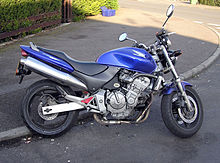Naked bike
Naked Bikes [ neɪkɪd baɪk ] are "naked" series road motorcycles , ie motorcycles without partial or full fairing. They are designed for use on (country) roads. The vehicle geometry ( steering head angle , wheelbase and weight distribution) and the chassis are usually designed for handiness.
history
The term naked bike became common in Europe in the mid-1990s. Almost every motorcycle until well into the 1980s was undisguised. Until then, full or partial fairings were only common in racing. Ultimately, naked bike is little more than the advertising term for a production motorcycle without full fairing in a class in which almost all motorcycles had a fairing for a while. The term was increasingly propagated by the manufacturers, but is now increasingly met with rejection in the motorcycle community. The term naked bike is frowned upon by lovers of classic motorcycles.
Typical "naked bikes"
(incomplete selection)
Advantages and disadvantages
Motorcycles with no fairing are valued for their "classic" appearance. Another advantage is that in the event of a slight fall, the - often expensive - paneling cannot be damaged. The engine and chassis are also more visible on an uncovered motorcycle than on a disguised machine.
By not using a panel, the wind pressure on the driver's head and upper body is significantly increased. The higher air resistance compared to a faired motorcycle requires more engine power for the same speed.
Other motorcycles without fairing
Honda CB 1300 Yamaha XJR, Suzuki GSX 1400 and others are also available for the retro - trend of the optics superbikes of the 1980s, the then class of big bikes .
Other types are:
Motorcycles with cockpit pulpit
Although they are not literally naked bikes, motorcycles with a standard or optional small cockpit fairing, such as Suzuki Bandit (e.g. Bandit 1200 S, Bandit 650 S), Suzuki SV (SV 650 S, SV 1000 S), Kawasaki, are used (e.g. Z 750, Z 1000, ZRX 1200 R) or Yamaha Fazer (e.g. FZS 1000, FZ 6 Fazer), also referred to as naked bikes.
The cockpit cladding does not offer comprehensive weather protection, but significantly reduces the wind pressure on the upper body at high speeds.
Individual evidence
- ↑ Archived copy ( memento of the original dated February 6, 2015 in the Internet Archive ) Info: The archive link was inserted automatically and has not yet been checked. Please check the original and archive link according to the instructions and then remove this notice.


